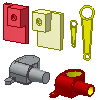 |
Creates a derived part using an Autodesk Inventor part as the base part. The solid bodies, visible 2D and 3D sketches, work features, surfaces, parameters, and iMates can be incorporated into the derived part. |
The derived part can be scaled larger or smaller than the original part or mirrored using any of the origin work planes of the base part. The location and orientation of the derived geometry is the same as the base part.
|
Access: |
Ribbon:
Manage tab
 Insert panel
Insert panel
 Derive
Derive
|
|
Derive style |
Provides the following commands, enabling you to choose to create a single body part with or without seams between planar faces, a multi-body part if the source contains multiple bodies, or a part with work surfaces. | |
|
|
Creates a single solid body part with merged seams between planar faces. | |
|
|
Creates a single solid body part which retains the seams between planar faces. | |
|
|
If the source contains a single body, creates a single body part. If the source contains multiple visible solid bodies, select the required bodies to create a multi-body part. This is the default option. | |
|
|
Creates a part with the selected bodies as base surfaces. | |
|
Status |
Provides the following commands, enabling you to change the status on multiple selected objects at the same time. |
|
|
|
Includes the selected geometry in the derived part. |
|
|
|
Excludes the selected geometry in the derived part. Geometry marked with this symbol is ignored when the derived part is updated in an assembly (changes to this geometry are not incorporated into the derived part). |
|
|
Symbols |
Controls the status of geometry and parameters associated with selected bodies. Either:
|
|
|
|
Indicates that the folder contains mixed included and excluded objects. |
|
|
|
Switches focus to the base part window so that you can take advantage of the selection commands and keep the Derived Part dialog open. |
|
|
|
Causes the Derived Part dialog box to absorb the selections you made in the base part window, returns to the Part environment, and highlights your selections in the dialog tree control. |
|
|
Sketches |
When selected, any unconsumed 2D or 3D sketches in the original part are included and can be used to create new geometry. |
|
|
Work Geometry |
When selected, any work features in the original part are included and can be used to create new geometry. |
|
|
Surfaces |
When selected, includes any surfaces that exist in the original part. |
|
|
Parameters |
When selected, any parameters in the original part can be used in the new part file. |
|
|
iMates |
When selected, includes any iMates defined in the original part. |
|
|
Show All Objects |
When selected, lists all exported and non-exported objects in the tree control. A hand |
|
|
Use color override from source component |
Selected by default. Clear the check box to remove color overrides. | |
|
Scale factor |
Default value is 1.0. Scale factor may be expressed in whole numbers of percentages (expressed with a decimal). Click arrow to select from recently used values. Note: Selected sketch block definitions and their instances are scaled. The scale factor is appended to the block name to indicate the block was scaled.
|
|
|
Mirror part |
Mirrors part when check box is selected. Specifies XY, XZ, or YZ origin work plane as the mirror plane. Click arrow to select the plane from the list. Note: Sketch block instances of selected block definitions are mirrored. However, the block definitions are not mirrored.
|
|
Context menu
The context menu offers the following options:
|
Expand All Children |
Expands all dialog tree folders nested under the selected node so that all contents are displayed. If no node is selected, expands all folders in the entire tree. |
|
Collapse All Children |
Collapses all dialog tree folders nested under the selected node so that the contents are not displayed. If no node is selected, collapses all folders in the entire tree. |
|
Find in Window |
In the graphics area, zooms to the component that is selected in the dialog tree. |